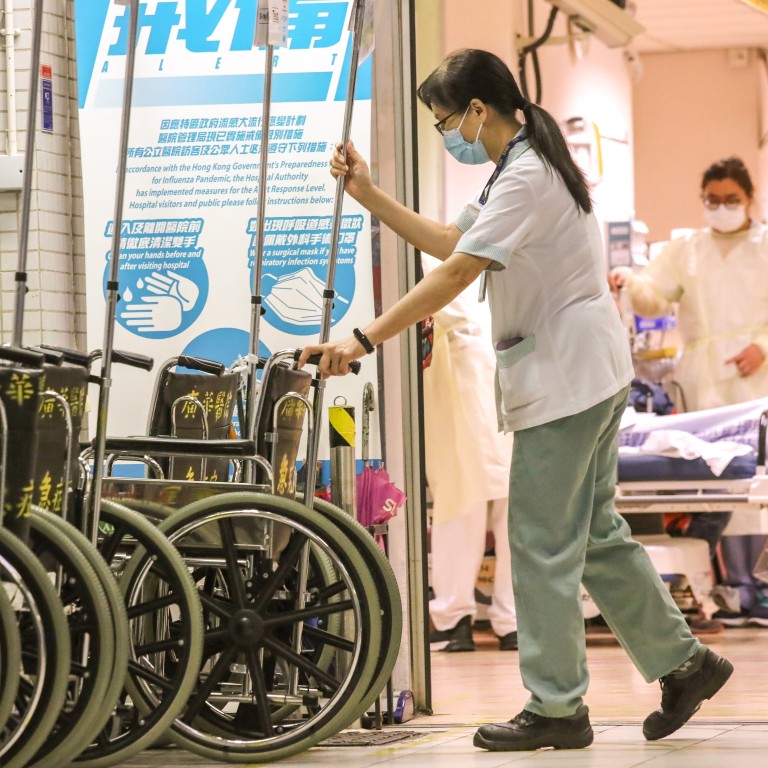
Officials say Hong Kong’s new government health insurance scheme on the right track, but observers unsure
- Officials involved in the year-old programme say figures hint it is having the desired effect of easing the burden on public hospitals
- Others say the current figures provide an incomplete picture, and that the scheme still has room for improvement
Nearly 90 per cent of policies bought under Hong Kong’s first government-backed health insurance scheme involved more affordable care options, officials have said, suggesting some early adopters might have switched services from the overburdened public health care system and gone private.
New findings on the first year of implementation of the Voluntary Health Insurance Scheme, which was launched in April last year, also showed that more than half of the scheme participants were aged 40 or younger.
The scheme, which aims to alleviate the burden on the public health care system, has issued 522,000 policies, 89 per cent of which were plans involving hospital stays in general wards – a more affordable option than semi-private or private wards.
“Those people might use public hospital services if they did not join the voluntary health insurance scheme,” said Deputy Secretary for Food and Health Fong Ngai, who oversees the scheme. “At a certain level, the scheme might be able to alleviate the pressure on public hospital wards.”
Hong Kong’s first government-backed health insurance scheme launched
The government had previously estimated that around 1 million people would join the scheme in its first two years.
The imbalance of patient loads between the public and private health care systems in Hong Kong has been a long-standing problem. Public hospitals, which employ around 40 per cent of the city’s doctors, provide care to about 90 per cent of inpatients.
Of the policies issued under the voluntary insurance scheme, 80 per cent were migrated from previously existing health insurance policies. The rest, or about 102,000, were newly issued.
Elaine Chan Sau-ho, a member of the scheme’s consultative group, said figures pertaining specifically to the newly issued policies might be more helpful in gauging how much the scheme was helping the public system.
“It was only those new health insurance buyers who could help reduce the burden on the public system,” Chan said.

Some new policies, however, could be explained by people purchasing an extra insurance plan on top of their existing ones, she added, which would similarly do little to ease the burden on the public system.
But even if all of the more than 100,000 new policies were from people who were new to the insurance market, Chan continued, it would be of minimal benefit to public hospitals. The public system recorded more than 1.1 million inpatient discharges and deaths in 2018-2019, according to the Hospital Authority.
Among the roughly 360,000 applications for the insurance scheme, 13,000, or 4 per cent, were rejected.
Hong Kong’s health insurance and pension saving schemes find traction in first two weeks
Derek Lee Chi-chung, head of the scheme, said the rejections generally were due to applicants’ pre-existing illnesses.
“Those who were older were more likely to be rejected,” Lee said.
Fong said the rejection rate was not considered to be high and noted that guaranteed acceptance could only be done through the operation of a high-risk pool, a mechanism involving government funding to help cover medical costs for people more prone to illnesses.
The mechanism had been proposed during the planning phase of the insurance scheme but was ultimately put on hold after public consensus could not be reached.
“When the operation of the scheme has gone to a stage widely accepted by the public, we would then initiate a review [of the possibility],” Fong said.
Of the 26,000 claims applications made in the first nine months of the scheme, about 1,000 were rejected for reasons such as involving procedures or pre-existing conditions not covered under the policy.
Study reveals scale of patients with private insurance being treated in state system
Average yearly premiums for the standard plan under the scheme range from HK$1,800 (US$232) to about HK$15,800, depending on age. Fong said it was unlikely for insurance companies to charge more for the plan if benefit levels did not change.
Tim Pang Hung-cheong, a patients’ rights advocate, said the government should look into why more than 10,000 people had their insurance applications rejected.
“Does it mean that some people could not join the scheme even if they have minor health risks? This might violate the intention of the scheme, which encourages people to use private health care services,” Pang said.
He said the government should launch a full review after the scheme had been operating for three years and look again into setting up a high-risk pool to allow all people to get insured in spite of pre-existing conditions.

